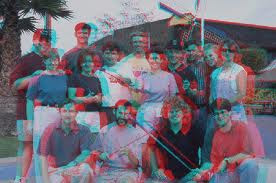3D photography has been around for many years. The essential part of it is taking 2 photographs at the same time, with 2 cameras separated by about 2-1/2", which is the average width of adult eyes. This provides 2 images, which differ just a bit. Then, you place one image in front of each eye, and you will then see "depth" in the set of 2D photographs.
The historical problem has been how to get those 2 images in front of your eyes separately. In the old days, you would use 2 small prints, with a separating paper between them. More recently, we've combined the images into one image, and used special glasses. The glasses are either polarized to mate with polarized prints, or different colored filters are used to mate with blue and red-colored sections of the print. We even have lenticular prints, with the two photographs"separated" into thin alternating strips below a lenticular sheet lens. This creates different images for each eye, as we look through the lenticular sheet, creating a number of graphic options, including 3D.
Here is an example of the separated color image.
While all these attempts have been successful in their day, over the last few years science has offered newer methods. With the creation of lasers, which use monochromatic light (light of one wavelength), the invention of holograms now offers new methods. Holograms have been around for a number of years, with their use on credit cards likely being the most popular use. The latest holograms offer 3D viewing without the need for special glasses, or even monochromatic lighting. However, the hologram images haven't been created from photographs; up to now.
With the advent of 3D modeling software, the capability now exists to convert a set of photographic images into a 3D model. Once we have that, there are now proprietary laser printers that can create a hologram from that 3D data set.
I'm investigating this newly developed capability for architectural photographs. Of course, now with 3D computer modeling, most of architecture design is done in the 3D computer world, but the finished building can only be captured in 2D now. I think the idea of seeing 3D in a photograph of a COMPLETED building
would be of great value to architects and others in the building
industry.
So, for now, stay tuned. I'll update you with any positive news in the coming months.
Thanks for reading,
Greg

No comments:
Post a Comment